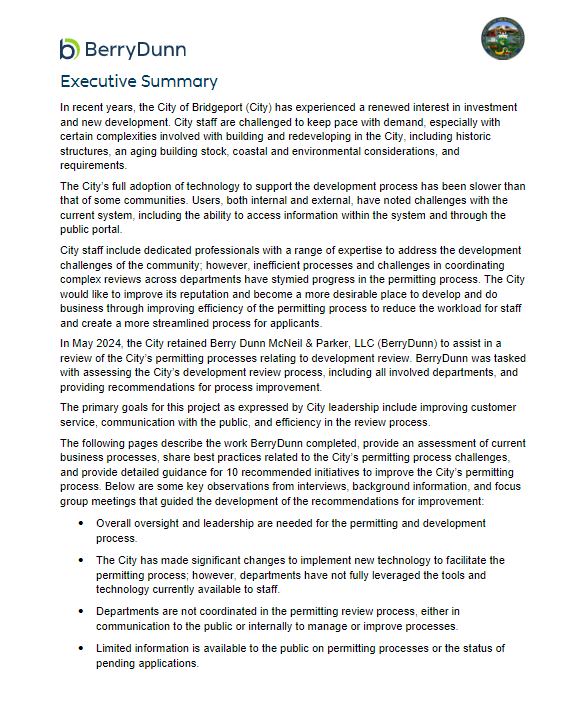The City Council commissioned a study of the city’s land management departments: Building, Zoning, Engineering, Fire Marshal, and WPCA.
BerryDunn a Maine-based consulting company that has worked with cities across the country, recommended reforms to improve the efficiency of the city’s permitting process and facilitate stronger communication with contractors and residents.
The firm will present its finding to the City Council Tuesday (today) 5:30 p.m. in the OPED Conference room of the Margaret Morton Government Center.
See full report Bridgeport Assessment and Recommendations for Improvement Report_FINAL (2)
Excerpt from executive summary:

0


If the project is a “pet” project of Ganim and his favorite developers, it gets done efficaciously. Maybe it gets stuck in zoning if it’s a “neighborhood destroyer” or is otherwise inappropriate, until the “resistance” gets worn down by cancelled/rescheduled meetings and all of the zoning officials get their arms bent enough to go along…
The issue with development in Bridgeport is that much of it is problematic for neighborhoods (asphalt plants, power plants, etc.) and existing businesses (the few that remain here) and/or they are not “favored” and pushed along by City Hall.
Official indifference. That is the main problem that is behind the inefficiency of getting things built in Bridgeport. If the top officials are enthusiastic about a project, it gets done efficaciously. Otherwise, it is a matter of how long the time, energy, and money of the developer can withstand the City Hall inertia…
Hard not to agree with Jeff
A lot of the times when I read a new small business has opened in Bpt,I always think to myself,”I got to get there before it closes down”
I have downloaded the study and am personally plowing through each section. My view at this moment is how frequently the word “challenge” is used in the narrative summaries as well as in the S/W/O/T format analysis where the word, STRENGTH is used, but not the word WEAKNESS. Is challenge merely a ‘concession to status quo politics’ where any change can be seen as a THREAT and OPPORTUNITIES are secured by qualified personnel, using adequate resources, with good communication, clear priorities in each ‘silo’ and across all ‘silos’, where City employees know that they will be evaluated regularly and oversight processes are part of routine governance. Are these the factors encountered in City of Bridgeport governance structure?
Diagrams of process are used to explain current and better practices. Would more diagrams, charts, or picture images communicate to and for the public? Time will tell.